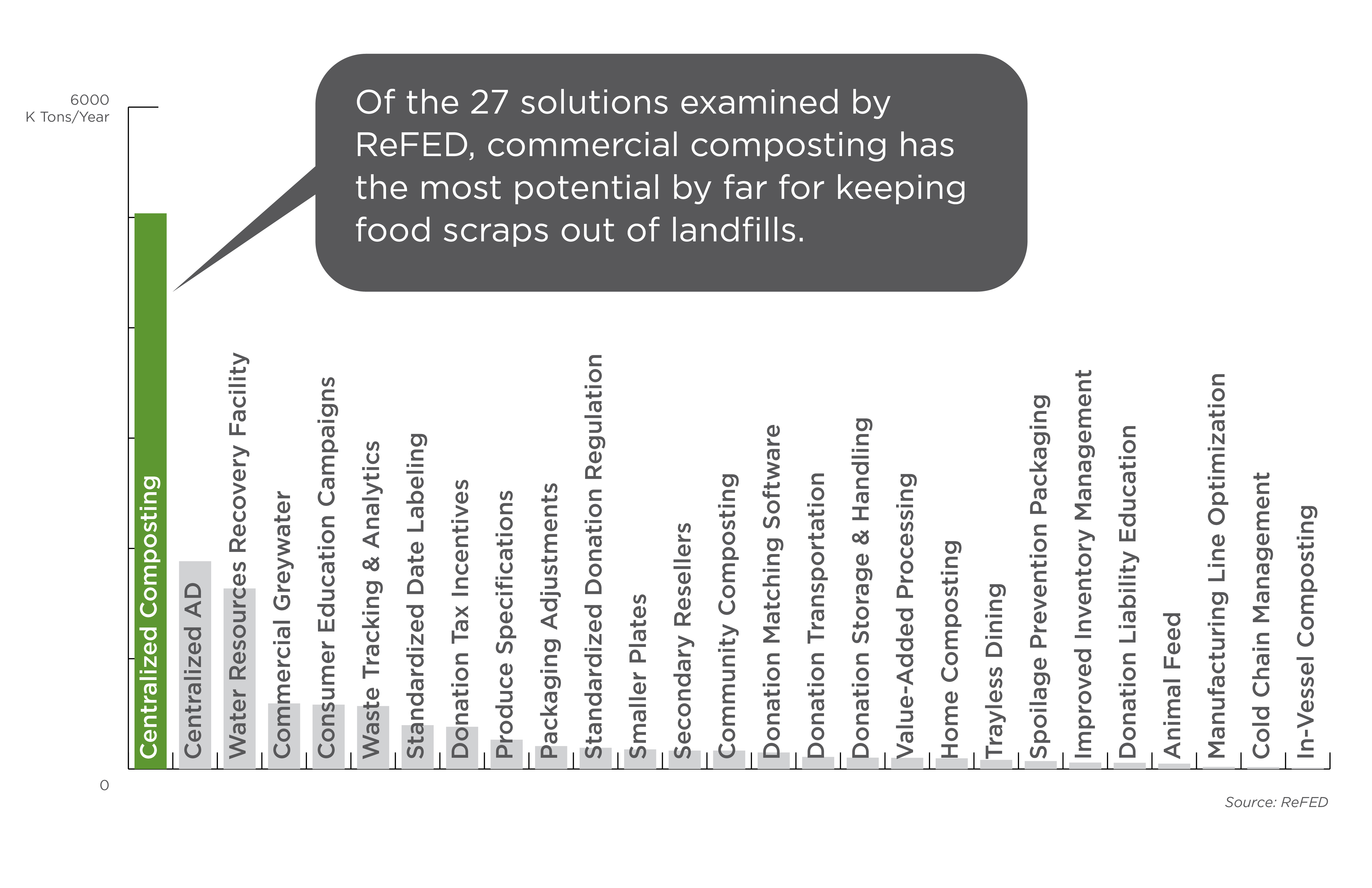Zero Waste is about keeping discarded materials out of landfills or incinerators so that they can be made into new useful resources people can use. It is about reimagining used items as inputs to something else, as items of value and not “trash.” Recycling and composting play key roles in this process, which is why widespread infrastructure is needed to make it possible.
Eco-Products is working with industry leaders to advocate for much-needed infrastructure that supports commercial composting. Why? Because of the half-eaten sandwiches left on our plates, remnants of chili or ice cream in our containers or the nacho cheese left on our trays.
Leftover food on our products is seen as “contamination” by recyclers. It messes up their recycling systems and decreases the value of recycled material they can sell. In contrast, composters want the food. It adds nutrients to their end product – the compost – which makes it all the more valuable.
When you consider most people don't take the time to read bin signage or sort items appropriately, it makes life much easier for concert-goers or sports fans if they can put both their compostable plate and uneaten fries in one bin. That's why compostable packaging is increasingly recognized as the most effective way to divert food scraps from the landfill.

But don't take our word for it. The latest report from the New Plastics Economy outlines a plan to create, use, and reuse plastics more sustainably. They believe a key way to increase plastic recycling from today's measly global rate of 10 percent to an aspirational 70 percent is by using compostable packaging for foodservice applications and building out commercial composting infrastructure.

Additionally, Rethink Food Waste Through Economics and Data (ReFED) – a collaborative working to reduce wasted food in the U.S. 50 percent by 2030 – reported that of the 27 solutions it analyzed to reduce wasted food, commercial composting had the greatest potential by far for keeping food scraps out of landfills, with over one-third of the potential volume.  The Institute for Local Self-Reliance also found that composting sustains four times more jobs than landfill or incinerator disposal on a per-ton basis, and lowers overall materials management costs.
The Institute for Local Self-Reliance also found that composting sustains four times more jobs than landfill or incinerator disposal on a per-ton basis, and lowers overall materials management costs.

These findings were music to our ears. It was affirming to receive third-party validation of the “systems solution” to materials diversion that we have been promoting for years.
Understanding the Challenges
of Commercial Composting
With evidence showing that composting can prevent millions of tons of food, packaging, and other organic materials from ending up in landfills, why aren't people composting more often?
The primary reason is that of the nearly 5,000 composting facilities in the U.S., only about 500 accept food scraps, according to BioCycle magazine, and fewer than this accepts compostable packaging. About $3 billion of investment is needed to expand commercial composting infrastructure nationwide.
Commercial composters also need to be convinced that accepting food and other compostable material makes good business sense. There are a few reasons for this:
- Composters must have a guaranteed amount of incoming materials, known as feedstock, to process into compost and make their business model work. Until more cities mandate composting or offer incentives for homeowners and businesses to compost, inconsistent supply makes it challenging for composters to secure financing.
- It takes time and money to sort out contamination – the non-compostable items – from compost bins. Waste-diverting entities, municipalities, and even composters all have a role to play in minimizing contamination.
- Lack of demand for compost reduces its market value. Without steady markets willing to purchase compost at a fair price, low prices challenge the business model.
- Supportive policies may not be in place. Securing permits for new or expanded facilities and coordinating with broader waste management infrastructure programs can be overly burdensome for composters. This can be streamlined with support from states and municipalities.
- Hauling routes need to be optimized. Ensuring a high inventory of customers and identifying efficient haul routes are critical to success, given the costs associated with transportation.
Identifying Solutions
– Former EPA Administrator Gina McCarthy
In the U.S., recycling and composting are not legislated at the federal level, and access to these services varies greatly by city and state. As a result, Americans recycle an average of 34 percent of all materials and compost just 5 percent of all wasted food.1
Despite the lack of federal laws on these topics, our country has acted to improve recycling and composting rates. Late in 2015, the U.S. Department of Agriculture and U.S. Environmental Protection Agency announced that they would create partnerships and put programs in place to reduce wasted food 50 percent by 2030.2 We were clearly excited to hear this news.
Actions We're Taking to Drive Zero Waste Infrastructure
Eco-Products is tackling Zero Waste both locally, where we operate, and nationally, where we support our customers and advocate on a broader scale. Here's a look at what we're doing:
Increasing Awareness
Understanding the value of Zero Waste starts with education – lots of it. We are doing our part to build awareness of this concept in nearly every conversation we have with our staff, peers, community leaders, and policymakers. We promote Zero Waste through this report, our website, our involvement in industry groups, and other channels.
Perhaps most importantly, providing Zero Waste consulting services to our customers is a core part of our offering. Could we just sell compostable cups and call it a day? Sure. But we don't stop there. We work with our customers to connect them to local composters and hold their hand as they implement waste diversion programs. See the next section on Zero Waste Operations for more details and inspiring success stories.
Engaging Industry Stakeholders
It takes a village to drive systemic change. That's why we forge relationships with industry partners that can leverage their resources and expertise to turn our collective dream of a Zero Waste future into reality.
For example, our marketing director serves on the board of the USCC and recently co-created its Food Scrap Composting Task Force. She and other board members spent the year setting up the roles and responsibilities of this group, which will be led by a commercial composter and become active in 2017.
Our marketing director also serves on the Advisory Committee for the Composting Collaborative. Eco-Products and the USCC helped lay the foundation for the development of this group in partnership with GreenBlue and BioCycle to drive sustainable materials management of organics and all compostables.
Additionally, our vice president of product strategy and development is currently serving as president of BPI’s board of directors. BPI is an association of government, industry and academia representatives who promote the use of compostable products by providing third-party verification of compostability. The majority of our GreenStripe® product line is BPI-certified.
Proving the Business Case
To help more composters see the value in accepting food scraps and compostable packaging, we recognize that more data is needed to make the case. Therefore, Eco-Products sponsors research to validate that composting makes good business sense.
Composters value food scraps because this material can be composted to enrich soils. Back-of-house food scraps come from kitchens and other food prep areas. These are less likely to be “contaminated” with non-compostable material because only staff have access to these bins. Composters may be more hesitant to accept leftover food that comes from “front-of-house” bins that the public uses because most people don't take the time to properly sort food and other materials.
This gets back to why we're obsessed with providing a systems solution to waste diversion. If all of the packaging is compostable, both the packaging and the leftover food can go in the compost bin. This greatly reduces the chance of contamination and increases the amount of material diverted from landfills.
Fortunately, there is a growing body of evidence that supports our case.
In 2016, Eco-Products sponsored a study conducted by GreenBlue's Sustainable Packaging Coalition to determine if using compostable packaging was a viable way to divert more food scraps (and thereby make it worthwhile for composters to accept front-of-house compostables). We measured the contents of front-of-house and back-of-house bins at the 2016 Farm Aid concert – an event that raises awareness and funding to support local farmers and a more sustainable approach to producing food in the U.S.
After 11 hours of digging through many stinky bags, dedicated workers and volunteers determined that a significant amount of food was captured from front-of-house bins. In fact, the composter received 120 percent more food scraps than it would have if it had accepted the back-of-house stream only. Based on these findings, researchers estimated that Farm Aid could divert 82.1 percent of the material collected at its concerts from the landfill if these practices were deployed at its events.
And what's really cool is that by using compostable foodservice packaging almost exclusively at the concert, the contamination rate was only about 5 percent. While this study and its methodology are still being peer-reviewed, all signs point to making a strong case to composters that if foodservice operators responsibly use compostable packaging (meaning they maximize the use of compostables, provide bin signage, and train staff), composters will get significantly more food scraps and hopefully manageable levels of contamination if they accept front-of-house organics.
Our support for this kind of research is far from over. In 2017, we will sponsor similar studies at other types of venues, such as corporate campuses and stadiums. We also plan to work with the Foodservice Packaging Institute (FPI) and other stakeholders to determine a feasible way to measure how many U.S. citizens currently have access to composting facilities that accept and compost foodservice packaging. We need that baseline data to determine how much the industry is moving the needle and to measure our progress going forward.
Finally, we've set a goal to expand access to composters who will accept and compost packaging in at least three local communities by 2020. This will be a tall order, but we must do what we can to make commercial composting a reality for more Americans.




